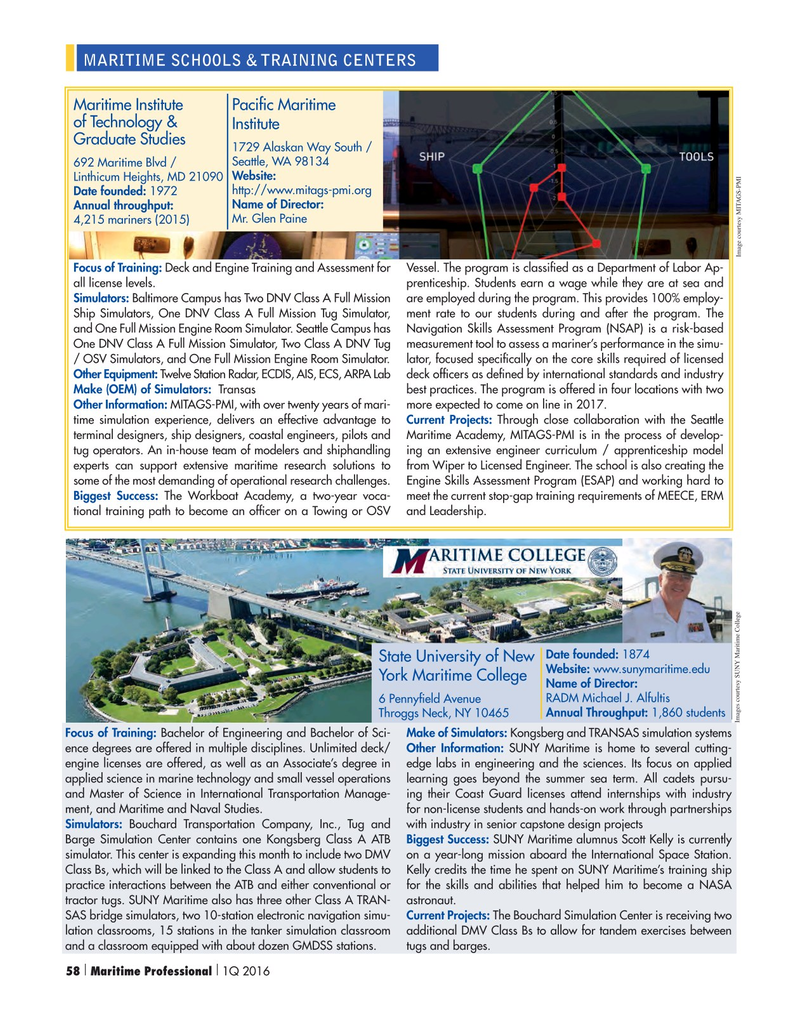
Page 58: of Maritime Logistics Professional Magazine (Q1 2016)
Maritime Training and Education
Read this page in Pdf, Flash or Html5 edition of Q1 2016 Maritime Logistics Professional Magazine
MARITIME SCHOOLS & TRAINING CENTERS
Maritime Institute Paci? c Maritime of Technology &
Institute
Graduate Studies 1729 Alaskan Way South / 692 Maritime Blvd / Seattle, WA 98134
Linthicum Heights, MD 21090 Website:
Date founded: 1972 http://www.mitags-pmi.org
Annual throughput: Name of Director: 4,215 mariners (2015) Mr. Glen Paine
Image courtesy MITAGS-PMI
Focus of Training: Deck and Engine Training and Assessment for Vessel. The program is classi? ed as a Department of Labor Ap- all license levels. prenticeship. Students earn a wage while they are at sea and
Simulators: Baltimore Campus has Two DNV Class A Full Mission are employed during the program. This provides 100% employ-
Ship Simulators, One DNV Class A Full Mission Tug Simulator, ment rate to our students during and after the program. The and One Full Mission Engine Room Simulator. Seattle Campus has Navigation Skills Assessment Program (NSAP) is a risk-based
One DNV Class A Full Mission Simulator, Two Class A DNV Tug measurement tool to assess a mariner’s performance in the simu- / OSV Simulators, and One Full Mission Engine Room Simulator. lator, focused speci? cally on the core skills required of licensed
Other Equipment: Twelve Station Radar, ECDIS, AIS, ECS, ARPA Lab deck of? cers as de? ned by international standards and industry
Make (OEM) of Simulators: Transas best practices. The program is offered in four locations with two
Other Information: MITAGS-PMI, with over twenty years of mari- more expected to come on line in 2017.
time simulation experience, delivers an effective advantage to Current Projects: Through close collaboration with the Seattle terminal designers, ship designers, coastal engineers, pilots and Maritime Academy, MITAGS-PMI is in the process of develop- tug operators. An in-house team of modelers and shiphandling ing an extensive engineer curriculum / apprenticeship model experts can support extensive maritime research solutions to from Wiper to Licensed Engineer. The school is also creating the some of the most demanding of operational research challenges. Engine Skills Assessment Program (ESAP) and working hard to
Biggest Success: The Workboat Academy, a two-year voca- meet the current stop-gap training requirements of MEECE, ERM tional training path to become an of? cer on a Towing or OSV and Leadership.
Date founded: 1874
State University of New
Website: www.sunymaritime.edu
York Maritime College
Name of Director: 6 Penny? eld Avenue RADM Michael J. Alfultis
Throggs Neck, NY 10465 Annual Throughput: 1,860 students
Images courtesy SUNY Maritime College
Focus of Training: Bachelor of Engineering and Bachelor of Sci- Make of Simulators: Kongsberg and TRANSAS simulation systems ence degrees are offered in multiple disciplines. Unlimited deck/ Other Information: SUNY Maritime is home to several cutting- engine licenses are offered, as well as an Associate’s degree in edge labs in engineering and the sciences. Its focus on applied applied science in marine technology and small vessel operations learning goes beyond the summer sea term. All cadets pursu- and Master of Science in International Transportation Manage- ing their Coast Guard licenses attend internships with industry ment, and Maritime and Naval Studies. for non-license students and hands-on work through partnerships
Simulators: Bouchard Transportation Company, Inc., Tug and with industry in senior capstone design projects
Barge Simulation Center contains one Kongsberg Class A ATB Biggest Success: SUNY Maritime alumnus Scott Kelly is currently simulator. This center is expanding this month to include two DMV on a year-long mission aboard the International Space Station.
Class Bs, which will be linked to the Class A and allow students to Kelly credits the time he spent on SUNY Maritime’s training ship practice interactions between the ATB and either conventional or for the skills and abilities that helped him to become a NASA tractor tugs. SUNY Maritime also has three other Class A TRAN- astronaut.
SAS bridge simulators, two 10-station electronic navigation simu- Current Projects: The Bouchard Simulation Center is receiving two lation classrooms, 15 stations in the tanker simulation classroom additional DMV Class Bs to allow for tandem exercises between and a classroom equipped with about dozen GMDSS stations. tugs and barges. 58 Maritime Professional 1Q 2016| | 50-63 Q1 MP2016.indd 58 2/29/2016 11:45:16 AM

 57
57

 59
59
